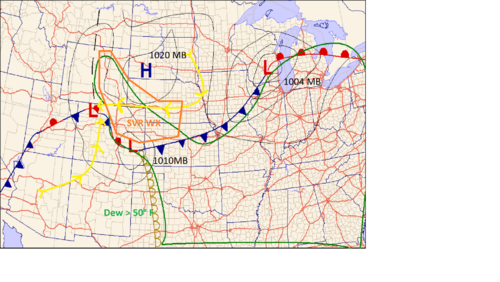I listened to a presentation today given by Reed Timmer
At about the 32:45 mark, he’s talking about events in the High Plains being mostly post-frontal events.
He said (roughly quoted), “With High Plains events you have to have a Cold Frontal passage usually, and then you play behind the front. When the winds switch back over to easterly, then the clouds clear and you get destabilization behind the front.
“They’re a lot different than the Dryline setups that you get in the Plains. And, because of the way they’re set up, a lot of times you get due easterlies all the way up to about a kilometer. So, if you look at the traditional indicies such as 0-1km shear, it doesn’t really show a very strongly sheared environment because you have easterlies similar in magnitude all the way up.
“But, between about a kilometer and 3 kilometers, they flip around to southwesterly or even more. So, you get a ton of shear through 0-3km.
“That’s why I always recommend using those indicies in the High Plains rather than the standard parameters used in the Plains.”
That’s all the info he gives about the subject. It really seems to be more of an aside in the video, but it’s made me interested because it seems so different than the things I’ve learned in basic meteorology courses.
Does anyone have suggestions of good resources to learn more about High Plains chasing? I’ve found a helpful detailed explanation of Upslope Flow by Jeff Duda in the post Forecasting Denver Area Tornadoes. And, a google search produces a lot of results, but they all seem to be little more than a one line definition of Upslope Flow.
At about the 32:45 mark, he’s talking about events in the High Plains being mostly post-frontal events.
He said (roughly quoted), “With High Plains events you have to have a Cold Frontal passage usually, and then you play behind the front. When the winds switch back over to easterly, then the clouds clear and you get destabilization behind the front.
“They’re a lot different than the Dryline setups that you get in the Plains. And, because of the way they’re set up, a lot of times you get due easterlies all the way up to about a kilometer. So, if you look at the traditional indicies such as 0-1km shear, it doesn’t really show a very strongly sheared environment because you have easterlies similar in magnitude all the way up.
“But, between about a kilometer and 3 kilometers, they flip around to southwesterly or even more. So, you get a ton of shear through 0-3km.
“That’s why I always recommend using those indicies in the High Plains rather than the standard parameters used in the Plains.”
That’s all the info he gives about the subject. It really seems to be more of an aside in the video, but it’s made me interested because it seems so different than the things I’ve learned in basic meteorology courses.
Does anyone have suggestions of good resources to learn more about High Plains chasing? I’ve found a helpful detailed explanation of Upslope Flow by Jeff Duda in the post Forecasting Denver Area Tornadoes. And, a google search produces a lot of results, but they all seem to be little more than a one line definition of Upslope Flow.

